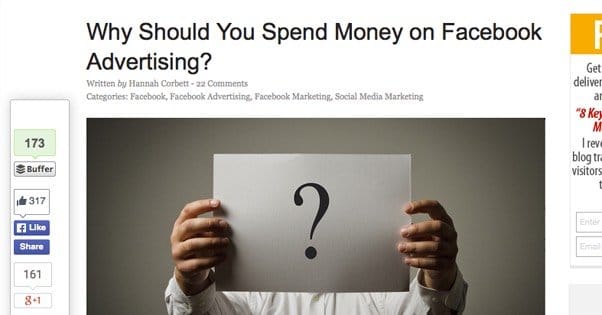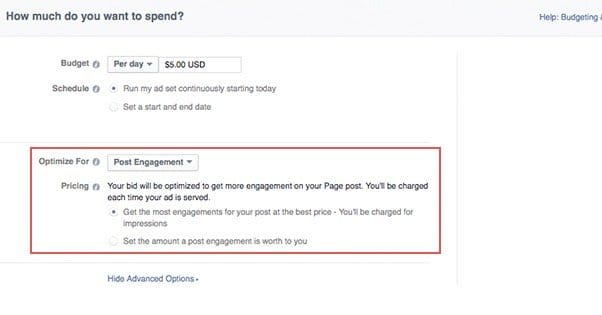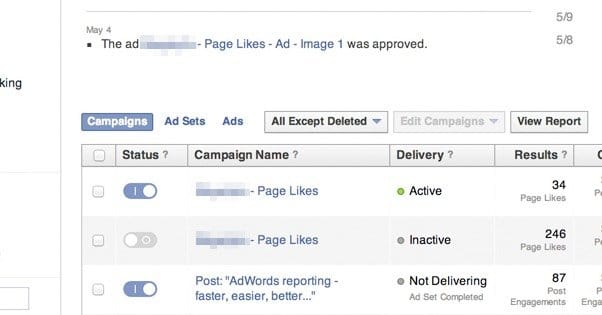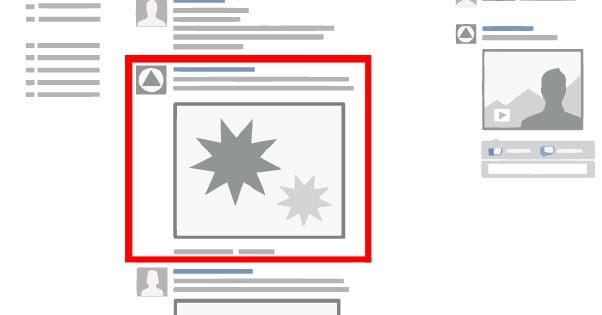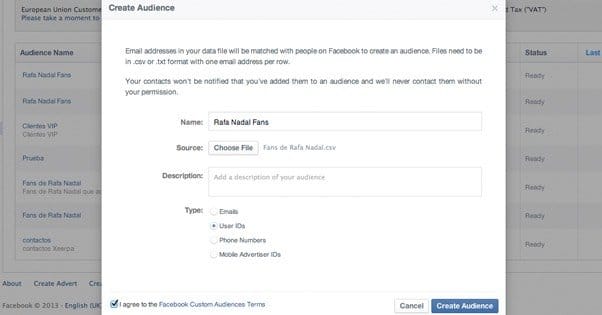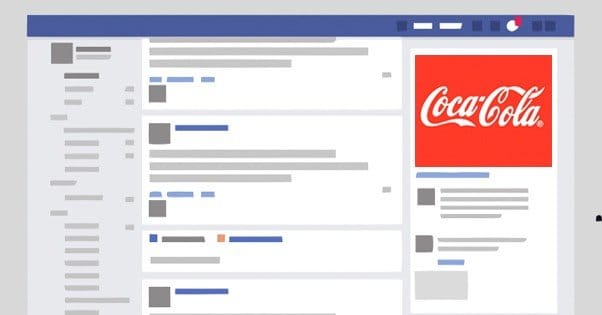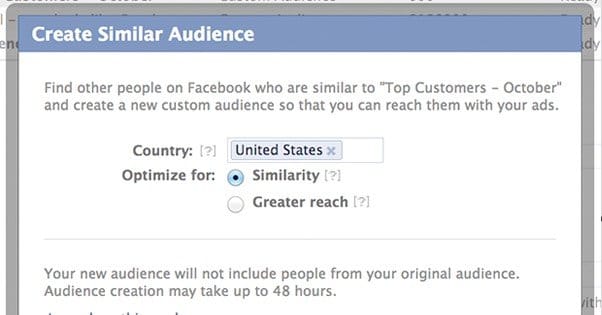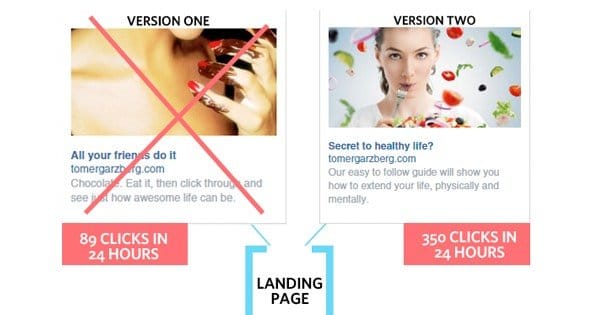 Written by ContentPowered.com
Written by ContentPowered.com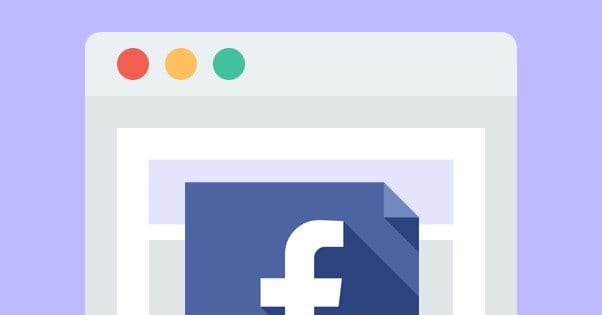
Time and again, I see jaded bloggers decrying Facebook ads as a fool’s errand. They rant and rail against the system, proclaiming that they’re nothing more than a scam, a means for Facebook to fleece marketers out of their thin advertising budgets.
On the other hand, many more marketers can and have found success with the site. After all, with billions of users comes millions of marketers, and at least some of them have to be successful. If not, the program likely wouldn’t exist.
I’m not here to tell you the virtues of using Facebook for ads. There are dozens of popular posts out there that will tell you that. Look, here’s one now. What I’m here to do is give you a set of rules and guidelines, as well as tips and tricks, to help you make Facebook ads work for you.
Anyone who claims Facebook ads don’t work or that they’re a scam just didn’t know what they were doing. I’ll admit this up front; Facebook is perfectly willing to take your money and give you nothing in return. They have a massive knowledge base, links everywhere to tips and guides, and there are thousands of guides and articles out there to research. Honestly, as easy as it is to lose money with Facebook ads, it’s still your own fault if you do.
That’s not to say losing money is bad. Well, I mean, it is, in a business sense. What you need to realize, though, is that every failed ad is a bit of knowledge about what doesn’t work. Take that ad, change the targeting, try again. Change the copy and try again. Keep trying, and adjust your thinking.
Your initial investment wasn’t a failure; it was purchasing experience and knowledge.
First, a Warning
Like I said, Facebook is more than willing to take your money and send views your way that are valueless to your business. This is because they just do what you tell them to do. They show your ads where you specify they be shown, to the people you tell them to target. They show the copy you make, the image you make, and the link you provide. If any of these are less than optimal, well, it’s not their fault.
First, don’t allow Facebook to control your budget. Daily limits are effective, but it’s also easy to accidentally mix up your ad spend. One good example is if an ad is largely ineffective. Facebook will offer you a button that can expand your targeting and optimize it for you, and they will give you an estimate of the people you will reach and the amount it will cost. It always costs more and you always reach fewer people; it’s just a fact of life. Don’t listen to Facebook, here. You can make the changes they would, but you can do it with more control and better tracking.
Second, always do tracking with an external analytics suite. Some people have issues with discrepancies between Facebook’s measurements and their own. There will be legitimate reasons for some of these, and others will just be issues with sampling, rounding or reporting. Having a secondary source of analytics to verify is important. I recommend using Google Analytics on your site and landing pages, using UTM parameters to track specific ads and specific campaigns, and using the Facebook Pixel to track from Facebook’s end.
Third, keep checking your ads. You should look in on their performance at least once each day, though if you have an extreme number of ads you can sample them and only check a few each day. The reason you want to check frequently is to prevent any instance where your ads are broken in some way but still running. Facebook will happily send people to your 404 page, but you really want to know if they are.
Finally, restrict country targeting. I don’t care if your business has a global audience; you can market to the worst areas in a different way. At the very least, you should block countries such as India, Bangladesh, and Pakistan from your ads. Most companies, small businesses in America for example, should restrict their ads to just American audiences. This is to prevent having your budget drained by clicks from users who have no money or no ability to convert. Your conversion rate will be low enough without having to combat clickfarms.
The Power Editor
The number one most essential tool for any Facebook marketer is the Facebook Power Editor. Power Editor is a plugin produced and maintained by Facebook, for the Chrome browser exclusively. You can find it here.
What Power Editor does is gives you a much more well laid out foundation for using the ads manager, along with a host of extra features. It’s very well documented and it’s the primary tool used by most professional ad managers on Facebook. It’s simply too valuable to do without.
That said, I’m going to try to keep my tips and instructions general enough that you can follow them whether or not you’re using Power Editor. I wouldn’t want to leave you out just because you prefer the old way, that would be silly.
Campaigns and Sets
The first thing to know about Facebook ads is that your campaign structure matters. Specifically, by grouping similar ads within ad sets, and using sets of ads within a campaign with multiple campaigns for different realms of marketing, you give yourself plenty of room with organization to test.
I like to use campaigns as the organizer of the general theme of the ads. This could be literally ad campaigns within an overall marketing plan, or it could be major segments of a large marketing campaign. Either way, ad sets would be individual ads for each purpose. One ad that sells a product, one ad that promotes your page, one ad that encourages users to visit your website, and so forth. Within the ad sets, you can have testing variations on each ad You might have ten or more variations of any given ad running for testing purposes, and keeping them grouped up into one set makes it easy to compare them side by side.
Ad Objectives and Their Benefits
There are ten different ad objectives you can choose for your ads, and they all have different purposes. Your first step to success with Facebook ads is picking the right objective for your ads. This is because Facebook does behind the scenes optimization based on the objective you pick, optimization you can’t replicate manually.
- Website Clicks – This objective is the closest to traditional PPC, sending users from Facebook to your website landing page. Once there, the ad has done its job. Use this only when you want traffic but don’t care about conversions.
- Website Conversion – This objective is geared towards getting people to click through to your website and also go on to convert. Ideal for opt-ins, offers, and product sales. You need the Facebook Pixel installed in order to use this objective.
- Post Engagement – This is the traditional news feed ad, a promoted post or a boosted post that tries to get users to like, share, or comment on that post to give it additional exposure.
- Page Likes – This objective tries to get users to like your page, to follow it and get updates you post in the future. This works best with a lookalike audience.
- App Installs/Engagement – These two are self-explanatory; they try to get a user to install an app or engage within an app. Neither are valuable unless you have an app to promote.
- Offer Claims – This allows you to create an offer for potential customers, which can be redeemed on your website. Ideal for free products or discount coupon codes.
- Local Awareness – This ad is a highly geo-targeted ad specifically most useful for mobile feeds, and it only works if you have a business with a physical location. Most targeting is taken out of your hands.
- Event Responses – This objective is focused on getting people to RSVP for your event, so obviously it’s only useful if you have and are promoting an event.
- Video Views – This objective is a video ad that promotes a video you uploaded to Facebook; it doesn’t work for one you host on YouTube or Vimeo.
Tips for Ad Copy That Sells
Your ad image is the attraction that gets people to look. There’s a fairly extensive guide to ad images coming soon. Either way, your image is just trying to get people to read your copy, and it’s the copy that gets them to click. So how do you make compelling copy?
First, consider a news feed ad. You have a post that looks organic, so you have the text at the top of the post, as your primary copy. Beneath that is the image, and beneath the image is your headline and description for the ad. All three of these locations need optimized copy.
Next, keep your post short. Facebook doesn’t have a character limit, but users have an attention span, and studies have shown that a post longer than 40-50 characters will lose their attention. It’s less than half of a tweet, so you have to be very conservative with your words.
Make sure your message is clear. A value proposition can be portrayed in an image and a couple sentences, and that’s what your ad description is for. Make sure that a user, looking at the ad, can see exactly what you want them to do and at least has an idea of what they get out of it.
Creating an Audience
By default, you have two audiences; everyone on Facebook, and everyone who follows your page. The “everyone on Facebook” audience is just the starting pool, which you refine down with targeting options.
In general, if your ad is geared towards getting more people to follow your page, you want to use an audience other than the people following you already. For everything else, your best bet for sales and conversions is the people who already follow you.
As for targeting options, there are a ton to pick through. You know how anyone can create a page, and anyone can like that page? Any created page can be used as an interest target. You can also use all sorts of demographics, from gender to income level to educational level to geographic location. You can even target people who are fans of your competitors, or any other company page.
Custom Audiences
Custom audiences are saved sets of targeting options. Every targeting option you set prunes down the “everyone on Facebook” audience into something smaller and more manageable. As I mentioned at the very start, your first targeting selection should be a geographic limiter. Every other targeting option should be geared towards putting your ad in front of a reasonable, interested audience.
Now, I can’t tell you how to target your ads. It’s an intensely personal customization, and it depends on your audience, your goals, and your ads. There are all kinds of tips and tricks, but they don’t always work for everyone, and I’m trying to give more general advice.
Retargeting
Retargeting is a special kind of custom audience. When a user visits your website through a Facebook ad, Facebook tracks them. If they convert, they’re added to one particular audience. If they don’t covert, they’re added to another.
Retargeting, or remarketing, is advertising specifically targeted at the people who visited your website and then left without converting. This audience is already highly interested, which you already know, because they visited your site. They might not have converted for any number of reasons, but many of those reasons are simply related to time. They want time to think, or they were at work and it wasn’t the right time to buy something.
Retargeting puts your ad in front of them again, reminding them that they were interested in your product, and gives them another chance to convert. It’s highly effective, and I strongly recommend using it.
Lookalike Audiences
Lookalike audiences are another form of custom audience. It’s created by taking the most prominent shared interests and demographics of your current audience, and finding other people on Facebook who share those characteristics.
You can generate a lookalike audience based on the people who follow you. You can generate one based on another custom audience, like the people you’d be retargeting. You can even generate one based on your mailing list, by importing your mailing list and using it as an audience.
Tracking Important Metrics
So now you know how to target audiences and how to create compelling ads. Now how do you know whether or not your ads are working? That’s where tracking information comes in. What metrics should you track?
- Raw number of actions. If you’re running ads to get page likes, track how many page likes you get. If you’re running ads to get people to convert on your website, track your conversions. If you’re running ads for engagement, it’s harder to track, so you’ll have to rely on Facebook’s reports.
- Cost per action. Take your total ad spend for a given ad, compare it to your number of actions generated through that ad, and figure out how much you spent per action. It’s like cost per click, but more relevant in every way.
- Ad frequency. Frequency is the number of times the average person in your audience sees your ad. If you have an audience of 100 and 50 people see your ad, you have a frequency of .5. If you have an audience of 100 and all 100 people see your ad twice, that’s a frequency of 2. You want a frequency of 1; any higher and people see your ad too often. Any lower and you’re missing part of your audience.
- Revenue. What good is it to track actions and ad spend if you don’t have the other side of the coin to compare it to? Having a really low cost per action is all well and good, but if it’s getting users to your site where they don’t buy anything, it’s earning you nothing. You want to make sure you’re actually profiting out of the deal.
Testing Ad Variations
And now we come to the truth, the final step, the real way to make money with Facebook ads; testing.
Split testing ads is pretty simple on Facebook. As I mentioned above, it’s really easy to keep all of your ad variations grouped up within a single ad set, so you have all the data to monitor in one place.
It’s also easy to create a single variation. Just take your original ad and fork a copy of it. Facebook allows you to base a new ad on an old ad, so do so, and change one thing about it. It’s very important that you only change one thing in your testing. If you change two or more variables, and I ask you what change you made that boosted your revenue, you wouldn’t be able to tell me.
You can test anything, as long as you’re careful to make the tests as close to even as possible. It’s not a valid test to run one ad for one day and another for five days and compare the numbers. Longer samples give you better data, but you don’t want to run them too long, lest you spend more money than you should on a bad ad.
I recommend running numerous variations at once, all testing one aspect of the ad. For example, you might run six ads with different images. When you find the one that works best, you can run six more variations of that one, each with different headlines. With a better headline in place, you can change up your targeting for each in subtle ways.
This testing process is how you go from making nothing to making everything with Facebook ads. It’s forced evolution, taking you from ads put together based on guessed, to ads based on fact. That, my friends, is the key to success. It’s not a gimmick, it’s not a secret formula, it’s not a hidden technique only master marketers know; it’s just time, practice, and a lot of testing.
